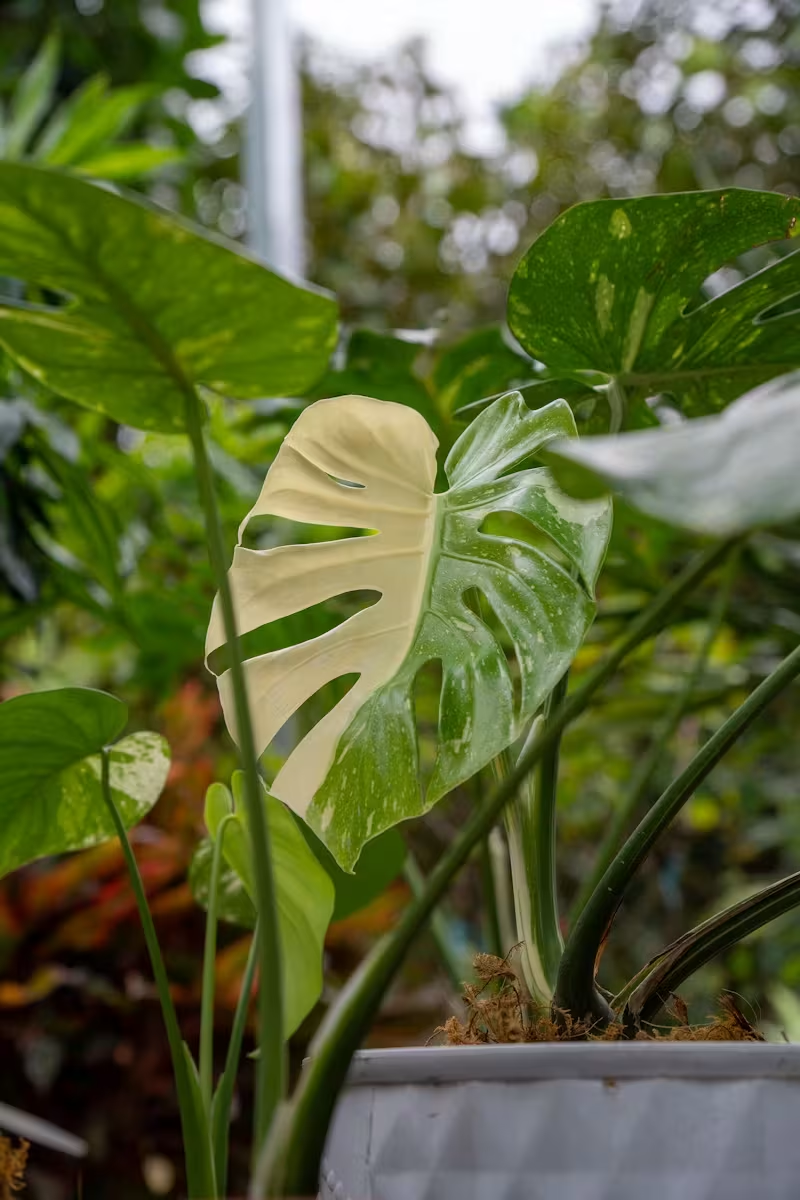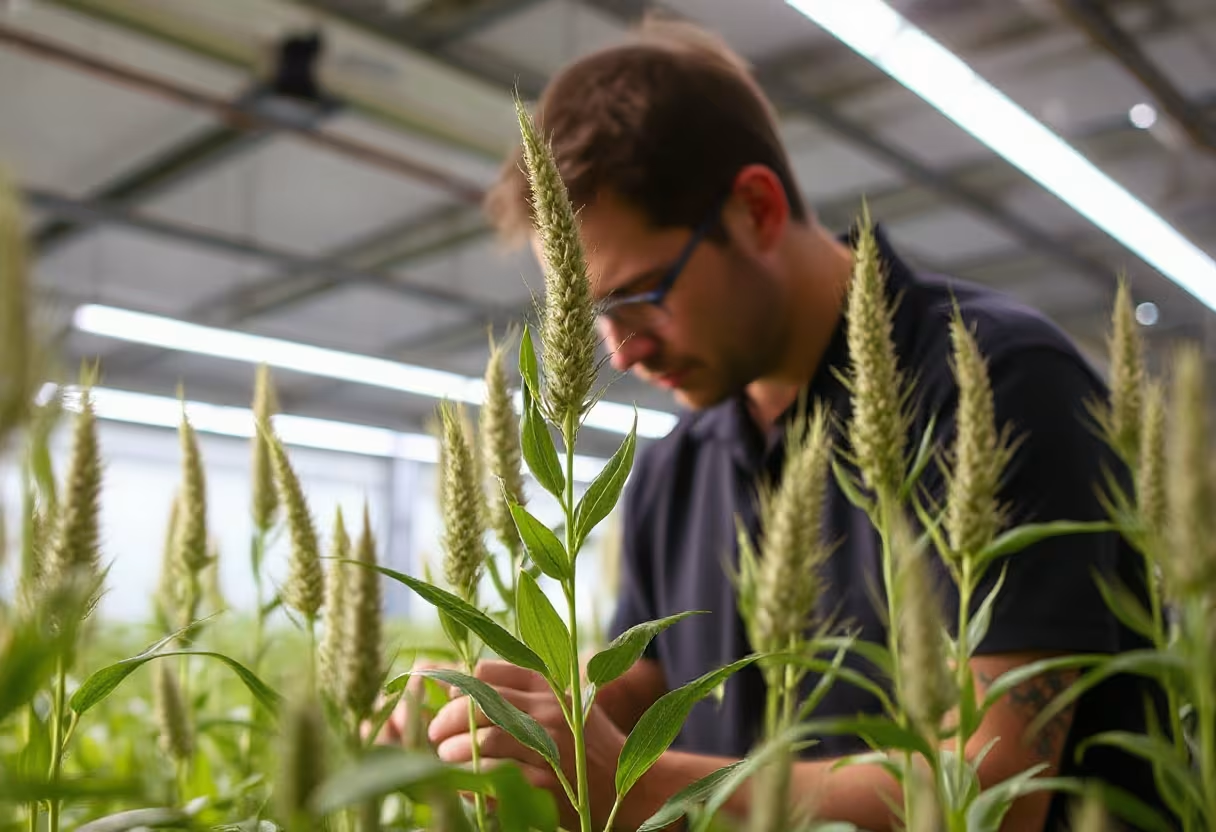The Secret Laboratory Revolution: How Scientists Are Engineering Tomorrow's Tropical Plants
From $3,000 Monsteras to CRISPR-edited crops, discover how secret plant labs are engineering tropical plants for beauty, resilience, and a climate-changed future.

The Secret Laboratory Revolution: How Scientists Are Engineering Tomorrow's Tropical Plants
While your Instagram feed fills with $3,000 variegated Monsteras, plant scientists are quietly engineering the future of tropical agriculture—and the results are more fascinating than any houseplant trend.
The $50 Billion Plant Engineering Revolution
In sterile laboratories across Thailand, Florida, and the Netherlands, scientists are performing what can only be described as botanical wizardry. They're creating plants that survive droughts, resist diseases, and produce yields that would have seemed impossible a decade ago. The global plant breeding industry has exploded to over $50 billion annually, with tropical plant innovations leading some of the most exciting breakthroughs.
But here's what's remarkable: the same scientific principles revolutionizing agriculture are being applied to create the exotic houseplants breaking the internet—and both industries are racing toward a climate-changed future that demands entirely new approaches to plant biology.
The Monstera Miracle: From Rainforest to Laboratory

The Tissue Culture Revolution
Take the Monstera Thai Constellation, that $1,500+ houseplant darling. Unlike its naturally occurring variegated cousins, Thai Constellation was born in a laboratory. Scientists use tissue culture—growing plants from individual cells in sterile conditions—to create stable variegation patterns that won't fade over time.
This isn't your grandmother's plant propagation. The University of Florida's foliage breeding program, the only organized foliage-breeding effort in the world, has developed techniques like wrapping newly pollinated spadices with moistened paper towels and placing them in plastic bags for 24 hours to set seeds. They're essentially hacking plant reproduction to create varieties that never existed in nature.
The Genetic Lottery of Variegation
Variegation—those striking white patterns on leaves—is essentially a controlled genetic malfunction. It's caused by random mutation, genetic mutation, or viral infection, making truly variegated plants incredibly rare, with odds of about 1 in 100,000.
The fascinating part? Light conditions control how much variegation appears. High light triggers genes that turn off chlorophyll-producing cells, creating those coveted white sections. Too little light, and the plant turns completely green to survive.
Beyond Instagram: The Climate Crisis Laboratory
The Urgent Mission
While plant enthusiasts obsess over aesthetic variegation, climate change is threatening global food security through extreme weather events, droughts, floods, and shifting growing conditions that could reduce crop yields by 25% by 2050.
This has triggered what scientists call "Breeding 4.0"—a revolution combining traditional breeding with cutting-edge genomic tools, artificial intelligence, and gene editing technologies.
The CRISPR Plant Revolution
CRISPR-Cas9 gene editing is transforming how scientists approach plant improvement. In 2024, countries worldwide approved new genomic techniques for agriculture, with Thailand, New Zealand, and European nations establishing regulatory frameworks for gene-edited crops.
Unlike traditional breeding that can take 10-15 years, CRISPR allows precise modifications to plant genomes, targeting specific traits like drought tolerance, disease resistance, and enhanced nutrition in a fraction of the time.
The Tropical Plant Breeding Goldmine
Florida's $2.8 Billion Secret
Florida accounts for more than 55% of national tropical foliage wholesale value annually, generating billions in economic activity. The state's tropical plant breeding program has created horticultural blockbusters:
- "Pearl and Jade" Pothos (2008): Features uniquely colored foliage with unusual splotches of greens and whites
- "Red Hot" Anthurium (1995): Became a bestselling potted plant due to bright red spathes and compact flowering
- "Golden Bay" Aglaonema (1999): Widely used in commercial interiorscaping with uniquely patterned silvery-gold foliage
The Innovation Pipeline
Scientists are applying growth regulators to Pothos, Philodendron, and ZZ plants to induce flowering on demand, obtain seeds, and select hybrids with entirely new foliage types. New tissue culture techniques allow researchers to evaluate varieties without growing plants to full size, reducing research time by two years or more.
The Climate-Smart Plant Revolution
Engineering Climate Resilience
The most exciting developments are happening at the intersection of aesthetics and survival. Scientists are creating tropical plants that can:
Survive Extended Droughts: New breeding programs focus on plants like pearl millet that tolerate prolonged water deficits and high temperatures, even enduring drought during reproductive phases.
Resist Extreme Weather: Advanced polytunnel and greenhouse technologies now protect over 30 crop types in more than 50 countries, using climate control and mechanical venting systems up to 5 meters in height.
Adapt to Changing Conditions: Pacific Island Countries are developing crop improvement strategies that exploit adaptive traits including abiotic stress tolerance and enhanced nutritional efficiency.
The Molecular Breeding Revolution
The International Rice Research Institute uses marker-assisted breeding to develop varieties that withstand drought, flooding, heat, cold, and soil salinity, providing greater accuracy and speed than traditional methods. Average yield increases of these climate-adapted varieties reach 0.8 to 1.2 tons per hectare under drought conditions.
The Economics of Plant Innovation
Market Forces Driving Innovation
The 2024 Tropical Plant International Expo attracted nearly 8,000 growers from all 50 states and 40 countries, showcasing innovations across nearly 200,000 square feet of showroom space. The industry's growth reflects massive consumer demand for unique, resilient plants.
The Numbers Tell the Story:
- Gene-edited berry varieties: 19 confirmed trait exemptions for seedless, thornless, and higher-yielding blackberry and raspberry varieties
- Ultra-high protein crops: Gene-edited soybeans with enhanced protein content approved for unrestricted marketing
- Climate-adapted varieties: First gene-edited wheat variety enhanced for disease resistance approved in China
The Innovation Timeline
Plant breeding timelines are accelerating dramatically. While traditional breeding cycles lasted 10-15 years, modern genomic selection and tissue culture techniques can reduce development time to 3-5 years for new varieties.

The Future Laboratory: What's Coming Next
AI-Powered Plant Design
Machine learning algorithms now analyze hundreds of thousands of plant traits across multiple growing environments, helping breeders make data-driven decisions about which genetic combinations to pursue. This "big data" approach is revolutionizing how scientists approach plant improvement.
The Convergence Revolution
The most exciting developments are happening where different technologies converge:
Genomic Selection + Tissue Culture: Creating stable, high-performing varieties faster than ever Climate Modeling + Breeding: Developing plants specifically adapted to predicted future conditions Consumer Trends + Scientific Innovation: Meeting aesthetic demands while building in climate resilience
The Sustainability Imperative
Modern breeding programs are incorporating wild, semi-domesticated, and "orphan" plants—locally known species that haven't undergone intensive artificial selection but possess valuable stress tolerance traits. These genetic resources are becoming crucial for developing plants that can thrive in changing climates.
The Challenges Ahead
The Complex Genetic Puzzle
Most important crop characteristics are polygenic traits controlled by multiple genes, making traditional breeding extremely challenging. Scientists are using QTL mapping and genome-wide association studies (GWAS) to identify genetic markers linked to desirable traits.
The Real-World Testing Gap
A major challenge is that most genetic research occurs under controlled laboratory conditions that don't reflect real field environments. Translating laboratory successes to commercial growing conditions remains a significant hurdle.
The Speed vs. Stability Balance
While new technologies enable faster breeding, maintaining high "selection intensity"—choosing the best performers from large populations—becomes more expensive as technology costs increase per individual plant.
Where Wayjaai Fits the Innovation Ecosystem
Spotting Botanical Trends Before They Bloom
While scientists work in 5-10 year development cycles, trends in plant preferences shift much faster. The houseplant boom, variegation obsession, and climate-conscious gardening didn't emerge overnight—they followed predictable patterns that trend analysis can identify.
Wayjaai's AI-powered trend analysis becomes invaluable for anyone in the plant industry. Instead of reacting to viral plant moments after they've peaked, you can position yourself ahead of emerging interests in:
- Climate-resilient varieties before mainstream adoption
- Unique foliage patterns before they become Instagram sensations
- Functional plant characteristics like air purification or low-water needs
From Scientific Innovation to Market Opportunity
When researchers at the University of Florida develop new Monstera varieties or Thai laboratories perfect tissue culture techniques, these innovations don't immediately reach consumer awareness. There's typically a 2-3 year gap between scientific breakthroughs and market trends.
Wayjaai bridges this gap by scanning multiple sources—from agricultural research publications to horticultural trade shows to social media conversations—identifying when scientific innovations are beginning to influence consumer interest.
Content Strategy for the Plant Revolution
The plant breeding industry produces endless content opportunities:
- Scientific breakthroughs translated into accessible explanations
- Behind-the-scenes laboratory stories that humanize complex research
- Climate adaptation angles that connect plant science to environmental concerns
- Economic impact stories about agricultural innovations
Wayjaai transforms these complex, scattered developments into ready-to-use content ideas complete with hooks, beats, and calls-to-action that resonate with both plant enthusiasts and sustainability-conscious audiences.
Organized Intelligence in a Complex Field
With thousands of research papers, patent applications, trade publications, and social media discussions happening simultaneously across the plant science world, staying informed becomes overwhelming.
Wayjaai's organized library lets you save and tag insights about:
- Emerging plant varieties entering development
- Climate resilience trends in agriculture
- Consumer preference shifts toward specific plant characteristics
- Economic opportunities in specialty plant markets
The Plant Revolution Is Just Beginning
We're witnessing the convergence of several powerful forces: advancing genetic technologies, urgent climate pressures, booming consumer interest in plants, and the economic potential of botanical innovation. This convergence is creating opportunities for content creators, businesses, and innovators who can spot trends before they fully emerge.
The next viral houseplant might be growing in a laboratory right now. The crop variety that feeds millions in a changing climate could be in early field trials. The breeding technique that revolutionizes tropical plant production might be published in an obscure agricultural journal.
Success belongs to those who can connect these dots—spotting the scientific innovations that will become tomorrow's trends, the research breakthroughs that will reshape markets, and the agricultural advances that will capture public imagination.
Whether you're creating content about the latest plant science, building a business around specialty varieties, or simply trying to understand where the botanical world is heading, remember: the future is being written in laboratories today.
The question isn't whether plant breeding will continue revolutionizing agriculture and horticulture—it's whether you'll spot the revolution before everyone else does.

Ready to stay ahead of the next wave in plant innovation? Discover how Wayjaai's AI-powered trend analysis transforms complex scientific developments into actionable content strategies.
Ready to create viral content?
Join thousands of creators using Wayjaai to generate trend-aware content ideas.
Start Free